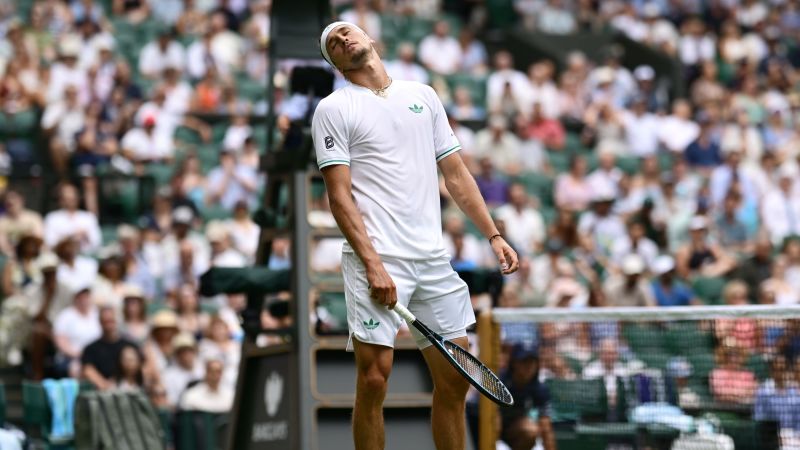
If there’s a crumb of comfort for seeded players who have already been dumped out of Wimbledon, it’s this: they are not alone. Tennis’ biggest names have been dropping at an unprecedented rate during the first week of this year’s tournament, throwing sections of the men’s and women’s draws wide open. This unexpected turn of events has led to a period of soul-searching for the world’s best players.
World No. 3 Jessica Pegula described her 58-minute defeat against Elisabetta Cocciaretto as “probably the worst result I’ve had all year,” while a tearful Coco Gauff lamented her straight-sets loss against Dayana Yastremska, saying it “definitely sucks.” Men’s third seed Alexander Zverev was even more candid, speaking of feeling “very alone” and trapped in a “hole” on the tennis court following his defeat to Arthur Rinderknech.
Record-Breaking First Round Exits
Pegula and Gauff were joined by fellow top-10 seeds Zheng Qinwen and Paula Badosa in their first-round exits, while Zverev, Lorenzo Musetti, Holger Rune, and Daniil Medvedev faced similar fates in the men’s draw. According to Opta, it’s the first time in the Open Era that eight players—men’s or women’s—seeded inside the top 10 have been eliminated in the first round of a Grand Slam.
“A tournament-record 13 seeded players in the men’s draw lost their opening matches, while Gauff became just the third woman in the Open Era to exit in the first round of Wimbledon having won the French Open a few weeks earlier.”
As of Friday, 19 seeded players have been knocked out of the men’s draw and 17 in the women’s. For Gauff, she believes the French Open title may have been the issue when it came to her Wimbledon loss. The American star said that a deep run at Roland Garros had hindered her going into the grass-court swing, while also citing it as a wider reason for the glut of upsets witnessed this week.
The Clay-to-Grass Transition
The transition from clay to grass tournaments is short and notoriously demanding for players, making dips in form even more likely. “I feel like, historically, Wimbledon always has so many upsets in the first rounds here, to be honest,” Gauff told reporters. “I think it’s always a topic. I would say really the quick turnaround—most of the seeds are going deeper in Roland-Garros … and then you have to come and try to adjust to grass.”
Clay and grass require contrasting tactics and styles of play. On clay, the ball bounces higher and spins more dramatically; on grass, shots tend to stay low and net-play, rather than long, baseline rallies, is rewarded. Additionally, play is slower and more methodical on clay, while grass is much faster. While players can stretch and slide on clay, grass courts don’t usually offer the same luxury.
“Movement on grass is completely different,” longtime coach Patrick Mouratoglou previously explained on his YouTube channel. “It’s a completely different feel, it’s a completely different way to move.”
The clay-to-grass transition has perhaps been made even more challenging by the Wimbledon courts being slower than usual, possibly due to the hot weather before and at the start of the tournament. Speed of play has been an issue mentioned time and again by players.
Depth of Talent and the Pressure of Grand Slams
Few players have mastered the switch from clay to grass, with Carlos Alcaraz an obvious exception. The Spaniard won his second title at Queen’s just two weeks after triumphing at the French Open last month, but even he struggled in his first-round match at Wimbledon, needing five sets to see off Fabio Fognini.
More than ever before, the well-worn adage that there are no easy matches at a Grand Slam has rung true during this year’s Wimbledon. It’s a testament to the depth of talent on display in the sport right now, a potential giant-slayer lurking in every round.
“The game is just really tough,” Frances Tiafoe said after his second-round defeat by Cameron Norrie, a former Wimbledon semifinalist who is unseeded at this year’s tournament. “It’s not like how it used to be where you can kind of, I mean, quote, unquote, ‘get to your seedings’ easier.”
That depth is always more evident at a Grand Slam, where stakes are higher and those lower down the rankings play like they have nothing to lose. For the bigger names in the draw, the nerves will be greater than at other events, making upsets more commonplace.
Fatigue and the Mid-Season Grind
Wimbledon also arrives midway through the calendar year—a point at which fatigue has begun to accumulate and the physical demand of the tour is taking its toll. That’s likely to be worse for higher-ranked players, who go deeper in tournaments and end up playing more matches.
“Honestly, I think everyone’s just kind of tired,” American sixth seed Madison Keys told reporters after progressing to the third round. “The season’s been long already. It’s hard. It’s been six months and I feel like we’ve all just played a lot of matches.”
For those lower-ranked players still in the men’s and women’s draws, this week’s Wimbledon could be the chance for a deep and career-defining run at a Grand Slam. Take one quarter of the women’s draw, where only two of the eight remaining players are seeded—a golden opportunity for a dark horse to reach a semifinal or beyond.
“Hopefully no upsets anymore in this tournament—if you know what I mean,” women’s top seed Sabalenka said after her second-round win against Marie Bouzkova. She was half-joking, half-all-too-aware of what has already happened to some of her biggest rivals.







